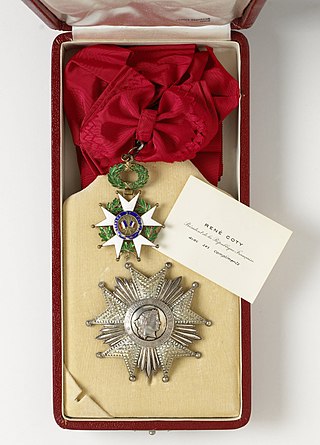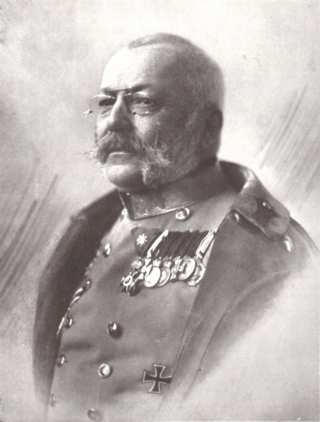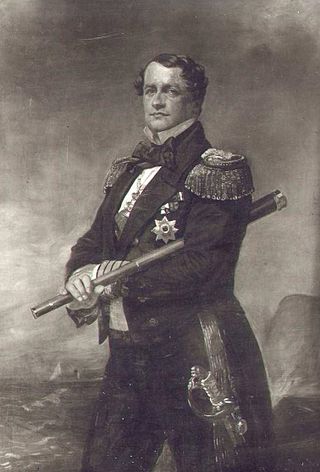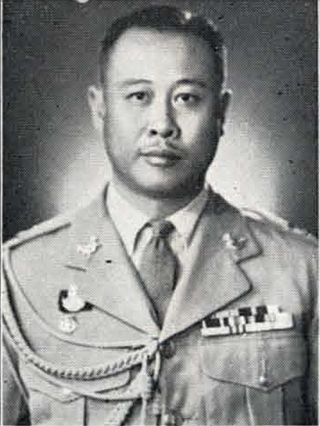
The National Order of the Legion of Honour, formerly the Royal Order of the Legion of Honour, is the highest French order of merit, both military and civil. Established in 1802 by Napoleon Bonaparte, it has been retained by all later French governments and regimes.

Archduke Friedrich, Duke of Teschen was a member of the House of Habsburg and the supreme commander of the Austro-Hungarian Army during World War I.

Field Marshal Thanom Kittikachorn was the leader of Thailand from 1963 to 1973, during which he staged a self-coup, until public protests which exploded into violence forced him to step down. His return from exile in 1976 sparked protests which led to a massacre of demonstrators, followed by a military coup.

The Order of Leopold is one of the three current Belgian national honorary orders of knighthood. It is the oldest and highest order of Belgium and is named in honour of its founder, King Leopold I. It consists of a military, a maritime and a civil division. The maritime division is only awarded to personnel of the merchant navy, and the military division to military personnel. The decoration was established on 11 July 1832 and is awarded by Royal decree.

Nikolaus Heinrich Ferdinand Herbert, Prince of Bismarck was a German politician, who served as Foreign Secretary from 1886 to 1890. His political career was closely tied to that of his father, Otto von Bismarck, and he left office a few days after his father's dismissal. He succeeded his father as the 2nd Prince of Bismarck in 1898. He was born in Berlin and died in Friedrichsruh.

Prince Heinrich Wilhelm Adalbert of Prussia was a son of Prince Wilhelm of Prussia and Landgravine Marie Anna of Hesse-Homburg. He was a naval theorist and admiral. He was instrumental during the Revolutions of 1848 in founding the first unified German fleet, the Reichsflotte. During the 1850s he helped to establish the Prussian Navy.

Frederick II was the last sovereign Grand Duke of Baden, reigning from 1907 until the abolition of the German monarchies in 1918. The Weimar-era state of Baden originated from the area of the Grand Duchy of Baden.

William, Prince of Hohenzollern was the eldest son of Leopold, Prince of Hohenzollern and Infanta Antónia of Portugal.

Alexander August Wilhelm von Pape was a Royal Prussian infantry Colonel-General with the special rank of Generalfeldmarschall.

Wilhelm Gustav Karl Bernhard von Hahnke was a Prussian Field Marshal, and Chief of the German Imperial Military Cabinet from 1888 to 1901.

Rudolf Graf Montecuccoli degli Erri was chief of the Austro-Hungarian Navy from 1904 to 1913 and largely responsible for the modernization of the fleet before the First World War.

Dietrich Graf von Hülsen-Haeseler was an infantry general of the German Empire.

Oswald Samuel Konstantin Freiherr von Richthofen, a German diplomat and politician, served as Foreign Secretary and head of the Foreign Office from 23 October 1900 to 17 January 1906.

Praphas Charusathien was a Thai military officer and politician. He was a field marshal of the Royal Thai Army and minister of interior in the governments of military rulers Sarit Thanarat and Thanom Kittikachorn.

Gustav Emil Bernhard Bodo von Kessel was a German general who served in the Austro-Prussian War, the Franco-Prussian War and World War I.

Prince Rudolf of Liechtenstein was an Austrian aristocrat, a general in the Common Army and one of the highest officials in the court of Emperor Franz Joseph I.

August Ludwig Traugott Botho Graf zu Eulenburg was an officer in the Prussian, and later German armies, and official in the Prussian royal court. He was the younger brother of Count Botho zu Eulenburg, who served as Minister-President of Prussia from 1892 to 1894, and a second cousin of Philipp, Prince of Eulenburg, the close friend of Kaiser Wilhelm II.





















